tl;dr
Instant.now()
2018-03-09T21:03:33.831515Z
Using Java 9 and later, you can likely capture the current moment with microseconds resolution.
Example seen above is Oracle Java 9.0.4 for macOS Sierra. Note the 6 digits of fractional second, meaning microseconds.
java.time
The java.time framework built into Java 8 and later has classes to represent date-time values with a resolution of nanoseconds, 9 digits of a decimal fraction of a second.
Java 9
The OpenJDK implementation of Java 9 has a fresh implementation of Clock with up to nanosecond resolution. Actual values depend on the limits of the underlying hardware clock of any particular computer.
For more info see the Question, Why does the new Java 8 Date Time API not have nanosecond precision?.
Avoid the older date-time classes. The classes such as java.util.Date/.Calendar bundled with early versions of Java have only millisecond resolution. Same for Joda-Time. Both are supplanted by the java.time classes.
Java 8
Java 8 implements the Clock interface with only millisecond resolution (3 digits of a fractional second). So while the java.time classes are capable of carrying nanoseconds, it is not able to capture the current time with nanoseconds.
Native code
Perhaps you could write or find an implementation of Clock that makes a call to a native library in the host OS to get a more accurate time.
Database
If you happen to be using a database already, you could ask it for the time. As of JDBC 4.2 and later, you can directly exchange java.time objects with your database.
Instant instant = myPreparedStatement.getObject( … , Instant.class ) ;
Prior to JDBC 4.2, you could go through the troublesome legacy java.sql.Timestamp that carries nanosecond resolution. For example, Postgres provides microsecond resolution (assuming the host computer clock supports that), 6 digits of a fractional second. You can convert from a java.sql.Timestamp to an Instant and ZonedDateTime using new methods added to the old classes.

About java.time
The java.time framework is built into Java 8 and later. These classes supplant the troublesome old legacy date-time classes such as java.util.Date, Calendar, & SimpleDateFormat.
To learn more, see the Oracle Tutorial. And search Stack Overflow for many examples and explanations. Specification is JSR 310.
The Joda-Time project, now in maintenance mode, advises migration to the java.time classes.
You may exchange java.time objects directly with your database. Use a JDBC driver compliant with JDBC 4.2 or later. No need for strings, no need for java.sql.* classes. Hibernate 5 & JPA 2.2 support java.time.
Where to obtain the java.time classes?
The ThreeTen-Extra project extends java.time with additional classes. This project is a proving ground for possible future additions to java.time. You may find some useful classes here such as Interval, YearWeek, YearQuarter, and more.
